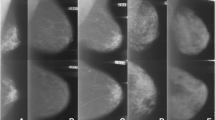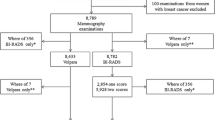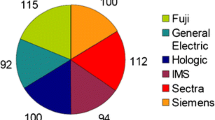Abstract
Purpose
The authors sought to assess interobserver agreement in classifying mammography density according to quantitative Breast Imaging Reporting and Data System (BI-RADS) criteria.
Materials and methods
Six expert mammography readers were tested on a set of 100 mammograms. Interobserver agreement was determined according to the kappa statistic, adjusting for chance agreement, on a four-category (D1 vs. D2 vs. D3 vs. D4) or two-category (D1–2 vs. D3–4) basis. Agreement with a panel of 12 readers who had been tested on the same set in a previous study was also assessed.
Results
The six readers showed good agreement when compared in pairs [agreement on a four-category basis was substantial (kappa=0.60–0.80) for 13 pairs and almost perfect (kappa>0.80) for two pairs); agreement on a two-category basis was substantial for 12 pairs and almost perfect for three pairs) or compared with the panel (on a four-category basis, agreement was substantial for five of six readers and almost perfect for one; on a two-category basis, agreement was substantial for all readers).
Conclusions
In agreement with previous studies, visual classification of mammography density according to BI-RADS quantitative criteria was highly reproducible among readers; nevertheless, attribution to the “dense breast” (BI-RADS D3–4) category, which might be adopted as a determinant of different screening protocols (such as adjunct ultrasonography or yearly interval) varied among readers (range 6–15%). Controlled studies should be performed comparing visual with computer-density category attribution, the latter possibly being a better alternative due to its absolute reproducibility.
Riassunto
Obiettivo
Scopo del presente lavoro è stato verificare la riproducibilità interosservatore nel classificare la densità mammografica in base ai criteri della classificazione quantitative Breast Imaging Reporting and Data System (BI-RADS).
Materiali e metodi
Sei lettori esperti di mammografia sono stati testati su un set di 100 mammografie. La concordanza interosservatore è stata valutata mediante la statistica kappa, che aggiusta per la concordanza casuale, rispetto a quattro (D1 vs. D2 vs. D3 vs. D4) o due categorie (D1–2 vs. D3–4). È stata verificata anche la concordanza con un panel di 12 lettori che avevano valutato lo stesso set di mammografie in uno studio precedente.
Risultati
I sei lettori hanno mostrato una buona concordanza quando confrontati in coppie (concordanza sulla base di quattro categorie sostanziale (kappa=0,60–0,80) per 13 coppie e quasi perfetta (kappa>0,80) per due coppie; concordanza sulla base di due categorie sostanziale per 12 coppie, quasi perfetta per tre) o rispetto al panel (concordanza sulla base di quattro categorie sostanziale per 5/6 lettori e quasi perfetta per un lettore; concordanza sulla base di due categorie sostanziale per tutti i lettori).
Conclusioni
In accordo con precedenti studi la classificazione visuale della densità mammografica secondo i criteri BI-RADS è risultata altamente riproducibile tra i diversi lettori: ciò nonostante l’attribuzione della categoria seno denso (BI-RADS D3–4), che potrebbe essere adottata come determinante di protocolli di screening differenziati (aggiunta dell’ecografia, frequenza annuale) varia tra i lettori (in questo studio dal 6% al 15%). Necessitano studi controllati che confrontino la classificazione visuale con quella computerizzata, potendo quest’ultima essere una valida alternativa per la sua riproducibilità assoluta.
Similar content being viewed by others
References/Bibliografia
Wolfe JN (1976) Risk for breast cancer development determined by mammographic parenchimal pattern. Cancer 37:2486–2492
Ciatto S, Zappa M (1993) A prospective study of the value of mammographic patterns as indicators of breast cancer risk in a screening experience. Eur J Radiol 17:122–125
Brisson J, Diorio C, Masse B, (2003) Wolfe’s parenchymal pattern and percentage of the breast with mammographic densities: redundant or complementary classification? Cancer epidemiol Biomarkers Prev 12:728–732
Vachon CM, Kuni CC, Anderson K et al (2000) Association of mammographic defined percent breast density with epidemiologic risk factors for breast cancer (United States). Cancer Causes Control 11:653–662
Boyd NF, Dite GS, Stone J et al (2002) Heritability of mammographic density, a risk factor for breast cancer. New engl J Med 347:886–894
Ursin G, Ma H, Wu H et al (2003) Mammographic density and breast cancer in three ethnic groups. Cancer epidemiol Biomarkers Prev 12:332–338
Chen Z, Wuy AH, Gauderman WJ et al (2004) Does mammographic density reflect ethnic differences in breast cancer incidence rates? Am J epidemiol 159:140–147
Egan RL, Mosteller RC (1977) Breast cancer mammography patterns. Cancer 40:2087–2090
Ciatto S, Visioli C, Paci e, Zappa M (2004) Breast density as a determinant of interval cancer at mammographic screening. Br J Cancer 90:393–396
Peeters PH, Verbeek AL, Hendriks JH et al (1989) The occurrence of interval cancers in the Nijmegen screening programme. Br J Cancer 59:929–932
Young K, Wallis M, Blank R, Moss S (1997) Influence of number of views and mammographic film density on the detection of invasive cancers: results from the NHS Breast Screening Programme. Br J Radiol 70:482–488
Buist DSM, Porter PL, Lehman C et al (2004) Factors contributing to mammography failure in women aged 40–49 years. J Natl Cancer Inst 96:1432–1440
Caumo F, Vecchiato F, Pellegrini M et al (2009) Analysis of interval cancers observed in an Italian mammography screening programme (2000–2006). Radiol Med 114:907–914
Caumo F, Brunelli S, Zorzi M et al (2011) Benefits of double reading of screening mammograms: retrospective study on a consecutive series. Radiol Med 116:575–583
American College of Radiology (2003) The ACR Breast Imaging Reporting and Data System (BI-RADS American College of Radiology, Reston
Ciatto S, Bonardi R, Zappa M (2001) Impact of replacement hormone therapy in menopause on breast radiologic density and possible complications of mammography in the assessment of breast masses. Radiol Med 101:39–43
Boyd NF, Wolfson C, Moskowitz M et al (1986) Observer variation in the classification pf mammographic parenchymal patterns. J Chroinic Dis 39:465–472
Berg WA, Campassi C, Langenberg P, Sexton MJ (2000) Breast imaging reporting and data system: inter- and intraobserver variability in feature analysis and final assessment. AJR Am J Roentgenol 174:1769–1777
Vachon CM, Sellers TA, Vierkant RA et al (2002) Case control study of increased mammographic breast density response to hormone replacement therapy. Cancer epidemiol Biomarkers Prev 11:1382–1388
Zhou C, Chan HP, Petrick N et al (2001) Computerized image analysis estimation of breast density on mammograms. Med Phys 28:1056–1069
Ciatto S, Houssami N, Apruzzese A et al (2005) Categorizing breast mammographic density: intra- and interobserver reproducibility of BI-RADS density categories. Breast 14:269–275
Landis JR, Koch GG (1977) The measurement of observer agreement for categorical data. Biometrics 33:159–174
Rosselli Del Turco M, Mantellini P, Ciatto S et al (2007) Full-field digital versus screen-film mammography: comparative accuracy in concurrent screening cohorts. AJR Am J Roetgenol 189:860–866
Pisano ED, Gatsonis C, Hendrick E et al (2005) Diagnostic performance of digital versus film mammography for breast-cancer screening. N engl J Med 353:1773–1783
Berg WA, Blume JD, Cormack JB et al (2008) Combined screening with ultrasound and mammography vs mammography alone in women at elevated risk of breast cancer. J Am Med Ass 299:2151–2163
Corsetti V, Houssami N, Ferrari A et al (2008) Breast screening with ultrasound in women with mammography-negative dense breasts: evidence on incremental cancer detection and false positives, and associated cost. Eur J Cancer 44:539–544
Corsetti V, Houssami N, Ghirardi M et al (2011) evidence of the effect of adjunct ultrasound screening in women with mammography-negative dense breasts: Interval breast cancers at 1year follow-up. eur J Cancer 47:1021–1026
Rafferty E, Smith A, Niklason L (2009) Comparison of three methods of estimating breast density: BI-RADS density scores using full field digital mammography, breast tomosynthesis, and volumetric breast density. Proffered paper at Rad Soc North Am, Chicago, USA: ssM01
Tuncbilek N, Sezer A, Uğr U et al (2009) Qualitative and quantitative analysis of fibroglandular tissue in the digital environment. Proffered paper at 10th National Congress of Breast Diseases, Izmir, Turkey
Author information
Authors and Affiliations
Corresponding author
Rights and permissions
About this article
Cite this article
Bernardi, D., Pellegrini, M., Di Michele, S. et al. Interobserver agreement in breast radiological density attribution according to BI-RADS quantitative classification. Radiol med 117, 519–528 (2012). https://doi.org/10.1007/s11547-011-0777-3
Received:
Accepted:
Published:
Issue Date:
DOI: https://doi.org/10.1007/s11547-011-0777-3




